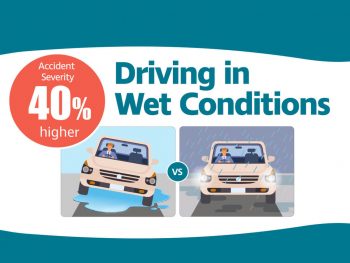Don’t let April shower your fleet with problems
A Teletrac Navman study of UK road accident data has highlighted that drivers should take more care on wet road surfaces when the weather is fine. This is timely reminder with April Showers upon us and the UK expecting an increase in the frequency of short but heavy downpours of rain, and this year even a bit of snow.

Accident severity is 40% higher when driving on a wet road surface
According to Richard Lilwall, Vice President and Managing Director, Europe at Teletrac Navman UK, “Accident severity is 40% higher when driving on a wet road surface when the weather is clear versus when it is raining, based on fatal accident rates. As we enter the period known for short periods of heavy rainfall drivers should be mindful of road surface conditions, as well as weather conditions and adjust their driving style accordingly.”
Teletrac Navman outlines some key considerations for operators, fleet managers and drivers, to ensure no one finds themselves in a predicament this April:
Road Types
The most dangerous road type when driving on wet/damp roads in clear weather conditions is a single carriageway, where 1 in 4 accidents are serious or fatal (25.4%). An accident in these conditions on a single carriageway is 23% more likely to be serious or fatal than the average across other road types.
Lighting Conditions
The most dangerous lighting conditions when driving on wet/damp roads, in fine weather is driving in darkness without lighting, where 32% (more than 1 in 4) accidents are serious or fatal. An accident in these conditions in darkness without lighting is 48% more likely to be serious or fatal than the average across other road types.
Urban v Rural
Accident severity rate is higher in rural roads with 27% of accidents being serious or fatal when the road surface is wet/damp and the weather is fine. This is compared to urban roads that is 22%. An accident is 20% more likely to serious or fatal when the road is wet/damp and the weather is fine on rural roads.
Safety Tips For Driving in Wet Conditions
Adjust Your Speed
Sustain lower speeds when road surfaces wet even if it isn’t raining. This will give you more time to react with longer stopping distances.
Increase Your Distance
Stopping distances relate to the road surface not the weather so it is important to sustain a large stopping distance even if it’s not raining anymore.
Tyre Tread
Ensure that your tyre tread is above legal levels and aim to keep them above 3mm. This will help you maintain traction on wet road surfaces.
Wiper Blades and Washer Fluid
When driving on wet road surfaces surrounding vehicle spray will affect your visibility, having wipers that in good condition and washer fluid is key to sustaining good visibility.
Use of Lights
When driving on wet road surfaces you want to be seen and keep visibility, but you also don’t want to dazzle other road users. With the road being highly reflective use your dipped beam and refrain from using full beam or fog lights.
To see the Teletrac Navman infographic with tips, click here.
.














